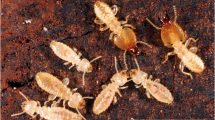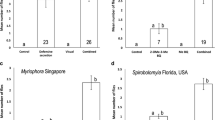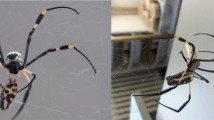Abstract
An important defensive strategy among animals is the use of chemical compounds with toxic or irritating properties. In this paper, we report the discovery of an Early Cretaceous soldier beetle (Coleoptera: Cantharidae) in Burmese amber that seemingly employed a chemical defense response against a potential predator. Six pairs of cuticular vesicles with associated gland reservoirs were extruded from the insect’s abdomen, and a secretion released from one of these covers a portion of the antenna of a second insect species, considered to be the perpetrator of the response. This is the earliest fossil record of a putative chemical defense response and suggests that chemical defense mechanisms in beetles have been in existence for at least 100 Ma.



Similar content being viewed by others
References
Blum, M. S. 1981. Chemical Defenses of Arthropods. Academic Press, New York.
Boucot, A. J. 1990. Evolutionary Paleobiology of Behavior and Coevolution. Elsevier, Amsterdam.
Brown, W. V., Lacey, M. J., and Moore, B. P. 1988. Dihydromatricariate-based triglycerides, glyceride ethers, and waxes in the Australian soldier beetle, Chauliognathus lugubris (Coleoptera: Cantharidae). J. Chem. Ecol. 14:411–423.
Bünnige, M., and Hilker, M. 2005. Do “glanduliferous” larvae of Galerucine (Coleoptera: Chrysomelidae) possess defensive glands? A scanning electron microscopic study. Zoomorphology 124:111–119.
Carpenter, F. M. 1992. Treatise on Invertebrate Paleontology. Pt. R. Arthropoda 4, vols. 3 and 4. Superclass hexapoda. Geological Society of America, Boulder.
Crowson, R. A. 1981. The Biology of the Coleoptera. Academic Press, London.
Cruickshank, R. D., and Ko, K. 2003. Geology of an amber locality in the Hukawng Valley, northern Myanmar. J. Asian Earth Sci. 21:441–455.
Daly, H. V., Doyen, J. T., and Purcell, A. H. 1998. Introduction to Insect Biology and Diversity. Oxford University Press, Oxford.
Dettner, K. 1987. Chemosystematics and evolution of beetle chemical defenses. Annu. Rev. Entomol. 32:17–48.
Dillon, E. S., and Dillon, L. S. 1961. A Manual of Common Beetles of Eastern North America. Row, Peterson & Co., Evanston.
Dumbacher, J. P., Wako, A., Derrickson, S. R., Samuelson, A., Spande, T. F., and Daly, J. W. 2004. Melyrid beetles (Choresine): a putative source for the batrachotin alkaloids found in poison-dart frogs and toxic passerine birds. Proc. Natl. Acad. Sci. U. S. A. 101:15857–15860.
Durvaux, C., Laurent, P., Daloze, D., Braekman, J-C., Lupoli, R., Dimarcq, J-L., and Pasteels, J. 2007. A new diterpene enone from the soldier beetle Cantharis livida (Coleoptera: Cantharidae). Arkivoc 10:5–9.
Eisner, T., Hill, D., Goetz, M., Jain, S., Alsop, D., Camazine, S., and Meinwald, J. 1981. Antifeedant action of z-dihydromatricaria acid from soldier beetles (Chauliognathus spp.). J. Chem. Ecol. 7:1149–1158.
Hilker, M., and Schulz, S. 1994. Composition of larval secretion of Chrysomela lapponica (Coleoptera, Chrysomelidae) and its dependence on host plant. J. Chem. Ecol. 20:1075–1093.
Meinwald, J., Meinwald, Y. C., Chalmers, A. M., and Eisner, T. 1968. Dihydromatricaria acid: acetylenic acid secreted by soldier beetles. Science 160:890–892.
Moore, B. P., and Brown W. V. 1978. Precoccinelline and related alkaloids in the Australian soldier beetle, Chauliognathus pulchellus (Coleoptera: Cantharidae). Insect Biochem. 8:393–395.
Pasteels, J. M., Brackman, J.-C., and Daloze, D. 1988. Chemical defense in the Chrysomelidae, pp. 233–252, in P. Jolivet, E. Petitpierre, and T. H. Hsiao (eds.). Biology of Chrysomelidae. Kluwer, Dordrecht.
Poinar, Jr., G. 1998. Trace fossils in amber: a new dimension for the ichnologist. Ichnos 6:47–52.
Poinar, Jr., G. 2000. Fossil onychophorans from dominican and baltic amber: Tertiapatus dominicanus n.g., n. sp. (Tertiapatidae n. fam.) and Succinipatopsis balticus n.g., n. sp. (Succinipatopsidae n. fam.) with a proposed classification of the subphylum Onychophora. Invertebr. Biol. 119:104–109.
Poinar, G. O. Jr., Buckley, R., and Brown, A. 2005. The secrets of burmese amber. Mid Am. Paleontol. Soc. 29:20–29.
Poinar, Jr., G. O., Lambert, J. B., and Wu, Y. 2007. Araucarian source of fossiliferous Burmese amber: spectroscopic and anatomical evidence. J. Bot. Res. Inst. Texas 1:449–455.
Spahr, U. 1981. Systematischer katalog der Bernstein-und Kopal-Käfer (Coleoptera). Stuttg. Beitr. Naturkd., B 80:1–107.
Sulc, K. 1949. On the repugnatorial stink-glands in the beetles of the genus Cantharis, Coleoptera. Bull. Intern. Akad. Tshèque Sci. 50:79–100.
Tschinkel, W. R. 1969. Phenols and quinines from the defensive secretions of the tenebrionid beetle, Zophobas rugipes. J. Insect Physiol. 15:191–200.
Tschinkel, W. R. 1975a. A comparative study of the chemical defensive system of tenebrionid beetles III. Morphology of the glands. J. Morphol. 145:355–370.
Tschinkel, W. R. 1975b. Unusual occurrence of aldehydes and ketones in the defensive secretions of the tenebrionid beetle, Eleodes beameri. J. Insect Physiol. 21:659–671.
Acknowledgements
Thanks are extended to Art Boucot and Roberta Poinar for comments on earlier drafts of this study.
Author information
Authors and Affiliations
Corresponding author
Rights and permissions
About this article
Cite this article
Poinar, G.O., Marshall, C.J. & Buckley, R. One Hundred Million Years of Chemical Warfare by Insects. J Chem Ecol 33, 1663–1669 (2007). https://doi.org/10.1007/s10886-007-9343-9
Received:
Revised:
Accepted:
Published:
Issue Date:
DOI: https://doi.org/10.1007/s10886-007-9343-9




